Traditional German Spaetzle Recipe
This post may contain affiliate links. See my disclosure policy.
One of Germany’s most popular and beloved foods, here is a fool-proof and authentic German Spaetzle recipe, just the way my Mutti and Oma made it! Perfect texture and perfect flavor, these are just like you know and love them from the Swabia region of Southern Germany where they originated!
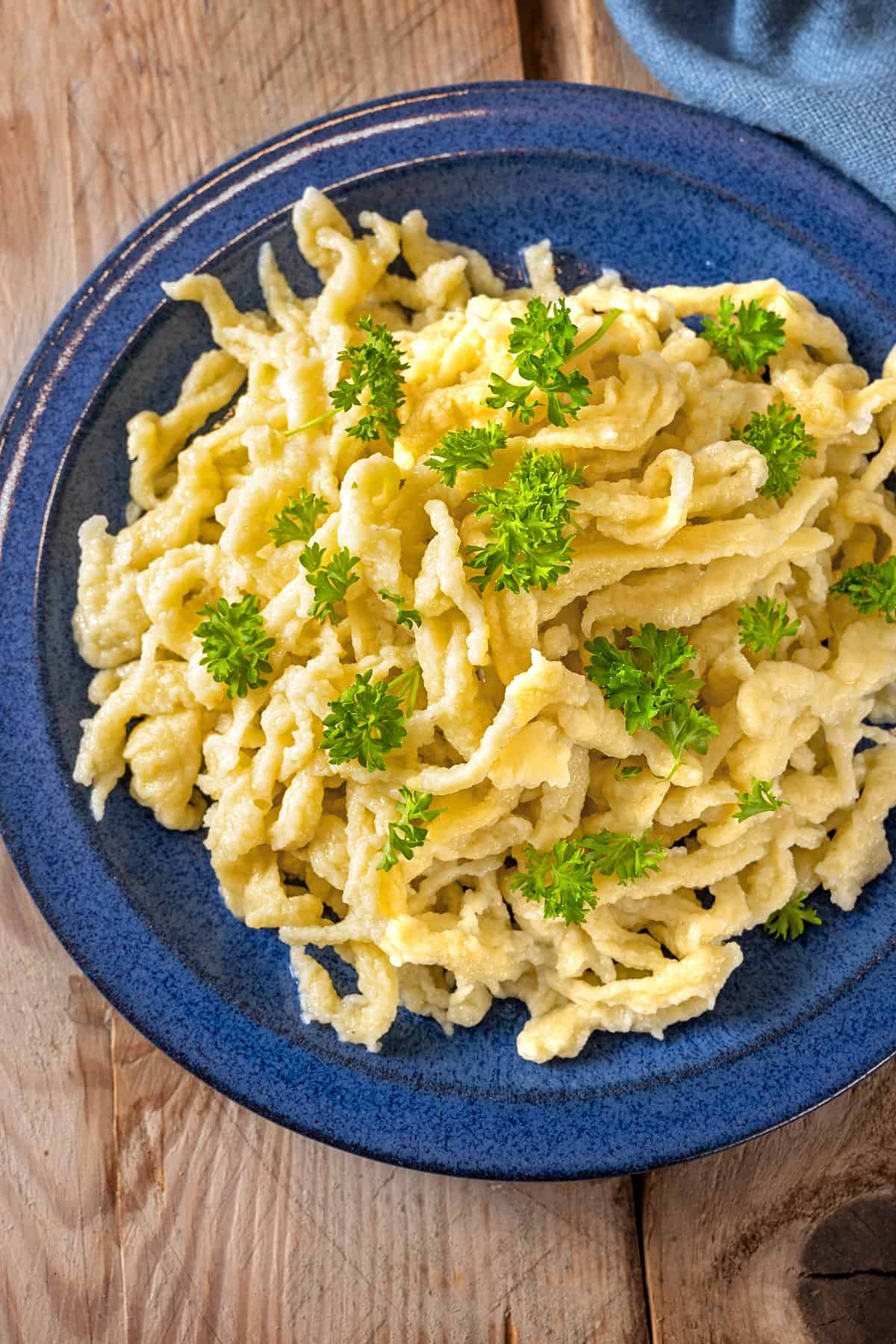
What is Spaetzle?
One of the most beloved foods in Germany that tourists go home talking about is Spaetzle, the famous German egg noodles from the Baden-Württemberg region of southwest Germany. This area is also known as Schwabenland, or Swabia. I grew up in Stuttgart, the capital of Baden-Württemberg, watching my Mom and Oma make Spätzle – I learned from the best!
Swabia is home to some of Germany’s best food (many, including myself, will argue it’s home to the best food in all of Germany). And that’s saying a lot because every region of Germany has amazing food. Swabia is known for its soups, sauces, meats, wursts, and salads, to name a few. It’s also home to some unique varieties of pasta including Spätzle, Schupfnudeln and Maultaschen.
Today we’re featuring Spätzle, a Swabian specialty that is also enjoyed in Austria and Switzerland. Spaetzle is a special type of egg noodle that is enjoyed with sauces and gravies as well as incorporated into a variety of different dishes. One example is Käsespätzle (a cheese spatzle casserole with crispy fried onions). Where did the name “Spätzle” originate? It comes from the German word Spatzen, meaning “little sparrows”, because that’s what they were thought to resemble when they were traditionally made by hand.
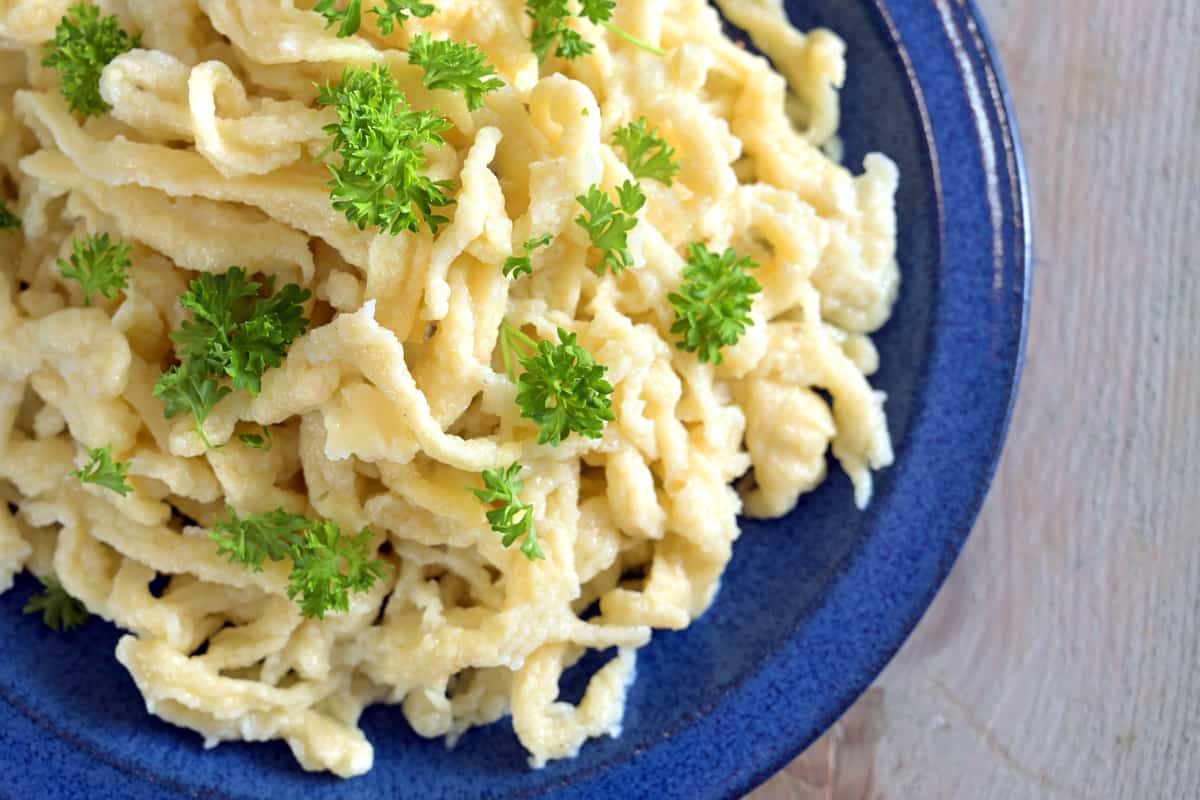
Spaetzle Ingredients
Spaetzle is a type of pasta and as such is made with a very few, simple ingredients that you’ll already have in your pantry. Here’s what you need:
- All-purpose flour: this creates a tender Spaetzle that still has a nice chewy texture.
- Eggs: these add richness and contribute to texture.
- Milk or water: You can use either but I prefer milk as it adds richness.
- Salt: enhances the flavor.
- Nutmeg: this is optional and is not traditional, though many German cooks today like to add it for flavor.
Spaetzle Recipe
Let’s get started!
This spaetzle recipe uses a stand mixer to knead/mix the dough. This is actually the first time I’ve made it that way. I’ve always done it by hand (you “knead” it by vigorously whipping it in a bowl with a spoon – over and over and over for around 20 minutes. It’s a lot of work!) I decided to to try it with a stand mixer instead and it turned every bit as good – and it sure saves a lot of muscle strain!
Add the flour and salt in the bowl of a stand mixer. Stir to combine. Crack four eggs into a bowl and whisk to combine. Make a well in the center of the flour and add the eggs. Add the milk or water and with the paddle attachment (I initially tried the dough hook and it didn’t work well), knead/mix the dough on the “2” setting for about 10 minutes to get a cohesive batter. Add more flour if the mixture is too runny, or more milk if it is too stiff.
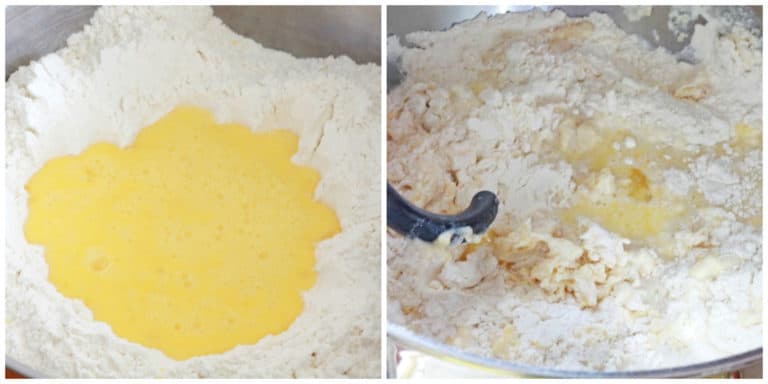
Pro Tip: How to Know When the Spätzle Batter is Ready
The batter is done when “bubbles” begin to form. After about 10 minutes of beating, use a wooden spoon and scoop and pull to stretch the batter; if bubbly holes appear, the dough is done. If not, continue “kneading” with the mixer for another minute or two, repeating the “test” process. See the bubble hole below?
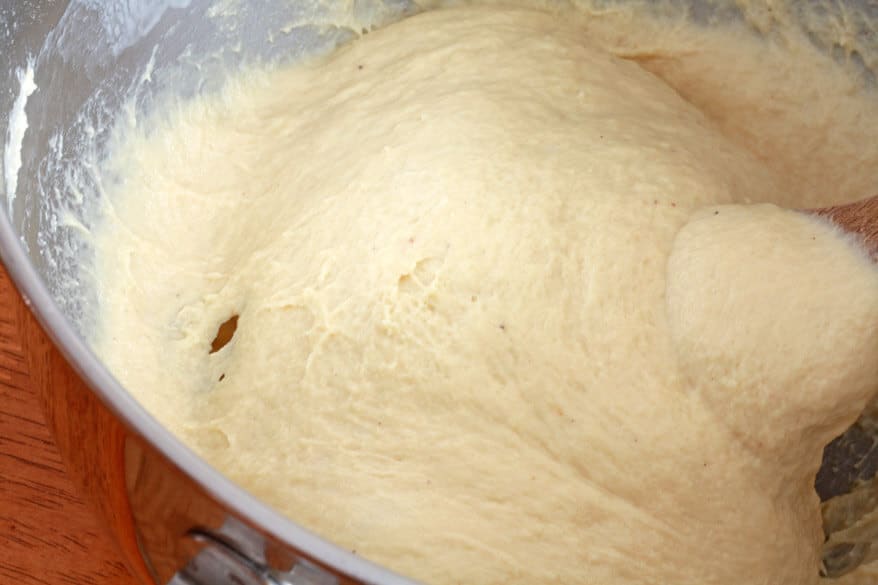
When those bubbly holes start appearing you know your batter is done.
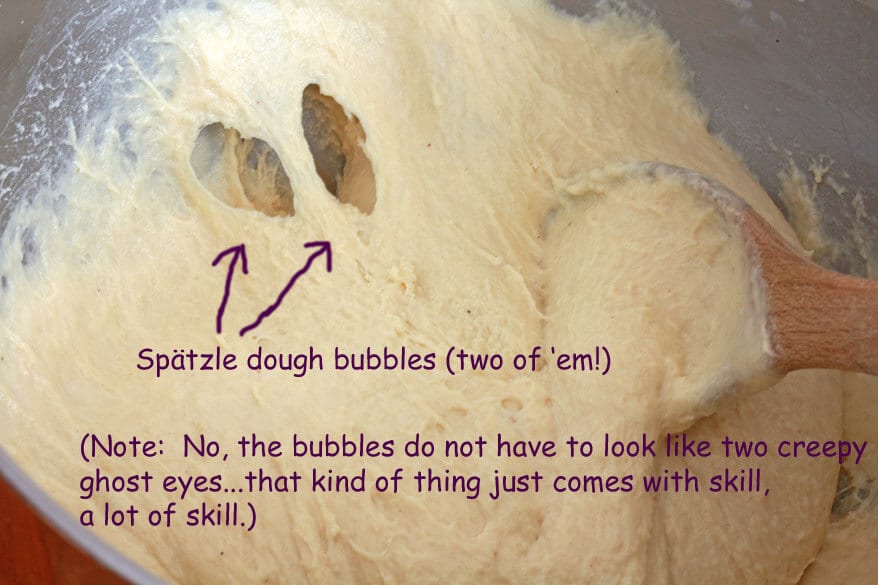
What Is the Best Spätzle Maker?
Now that the batter is read it’s time to make the Spätzle. And when it comes to the Spaetzle maker, there are a few options to choose from. Traditionally, Spätzle was made by hand using a Spätzlebrett, or Spaetzle board. You would rub a slab of dough out onto a wetted board and use a pastry cutter or long sharp knife to quickly cut off strands of the dough into simmering water. Swabian women of previous generations were highly skilled at this and could do it so fast it would make you dizzy to watch. Nowadays most Germans use a Spätzle maker (and even more just buy it ready made at the store. It’s the “convenience generation”).
Besides the traditional Spätzle board there are a few different kinds of Spätzle makers out there that you can find online:
- Spätzle Press (below left): That is my Spaetzle maker that I brought with me from Germany when I moved to the U.S. and it’s awesome. This kind is pricey but it will last a lifetime. It’s called the Original Kull Spätzle Maker and is made in Germany. It’s built like a tank and will become a family heirloom you can pass down for generations. Another brand that is much cheaper and is also made in Germany is this Westmark Spätzle Maker. These Spätzle presses can also be used as potato ricers.
- Spätzle Scraper (below right): Another option is the Küchenprofi Spätzle Lid & Scraper. I’ve used this one as well with good results and it’s much cheaper. It produces a shorter, stubbier spatzle noodle. Alternatively you can also use a metal steamer because it’s similarly constructed with large holes. You place some of the dough in the steamer over the simmering water and scrape the dough through the holes.
- Spätzle Plane: A third option is the Küchenprofi Spätzle Plane with Pusher, which is my least favorite as it can be a little clumsy, messy, and more difficult to work with but I know people who use it.
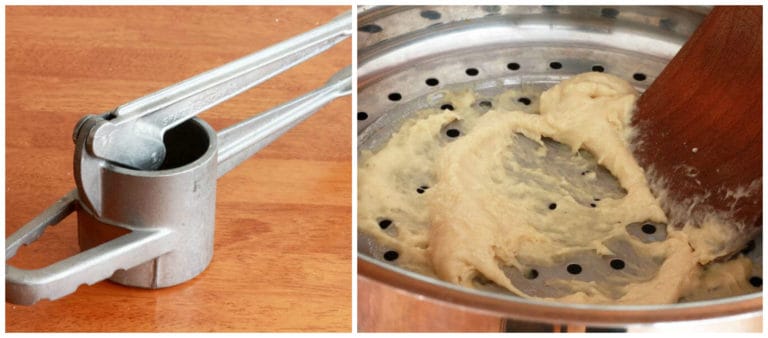
My personal favorite is the Spätzle press and that’s what I’m using in the pictures below. Place the Spaetzle maker over a pot of lightly salted simmering water and scoop some dough into it.
Press the Spätzle maker down to squeeze the Spätzle noodles out into the simmering water. Simmer the Spätzle for about 2-3 minutes or until they float to the top.
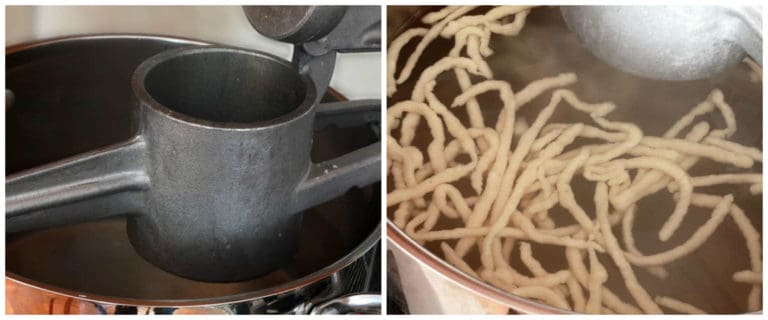
Using a slotted spoon, transfer the Spätzle to a colander and then immediately put them in a bowl of very cold water. This helps them firm up to the desired consistency.
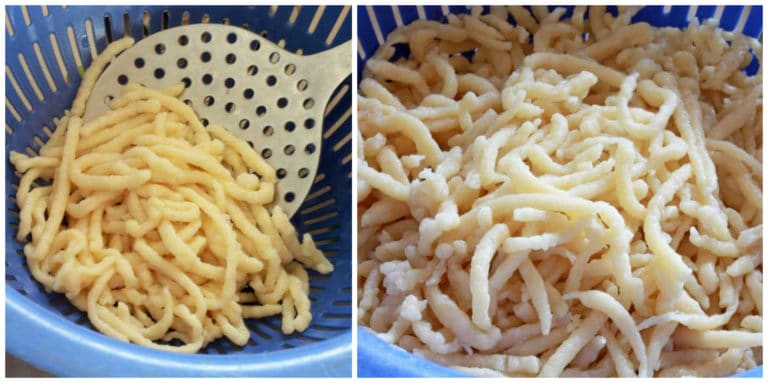
Drain the Spätzle again and toss with a little oil or melted butter to keep them from sticking.
Spätzle will keep in the fridge for at least a couple of days and then heated to serve. Melt some butter in a pan and toss the Spaetzle in it to warm through.
Storage & Freezing
Spaetzle can be made in advance, cooled, and stored in a covered container in the fridge where it will keep for 3-4 days. To reheat it you can microwave it in a microwave-safe container or, my favorite way, is to melt some butter in a large skillet, add the Spätzle and heat through. Spaetzle also freezes well for up 3 months: put it in a freezer-safe container and let it thaw overnight in the fridge. It can be reheated in the microwave in a covered container so that it doesn’t dry out, or you can melt some butter in a pan and toss the Spaetzle in it until warmed through.
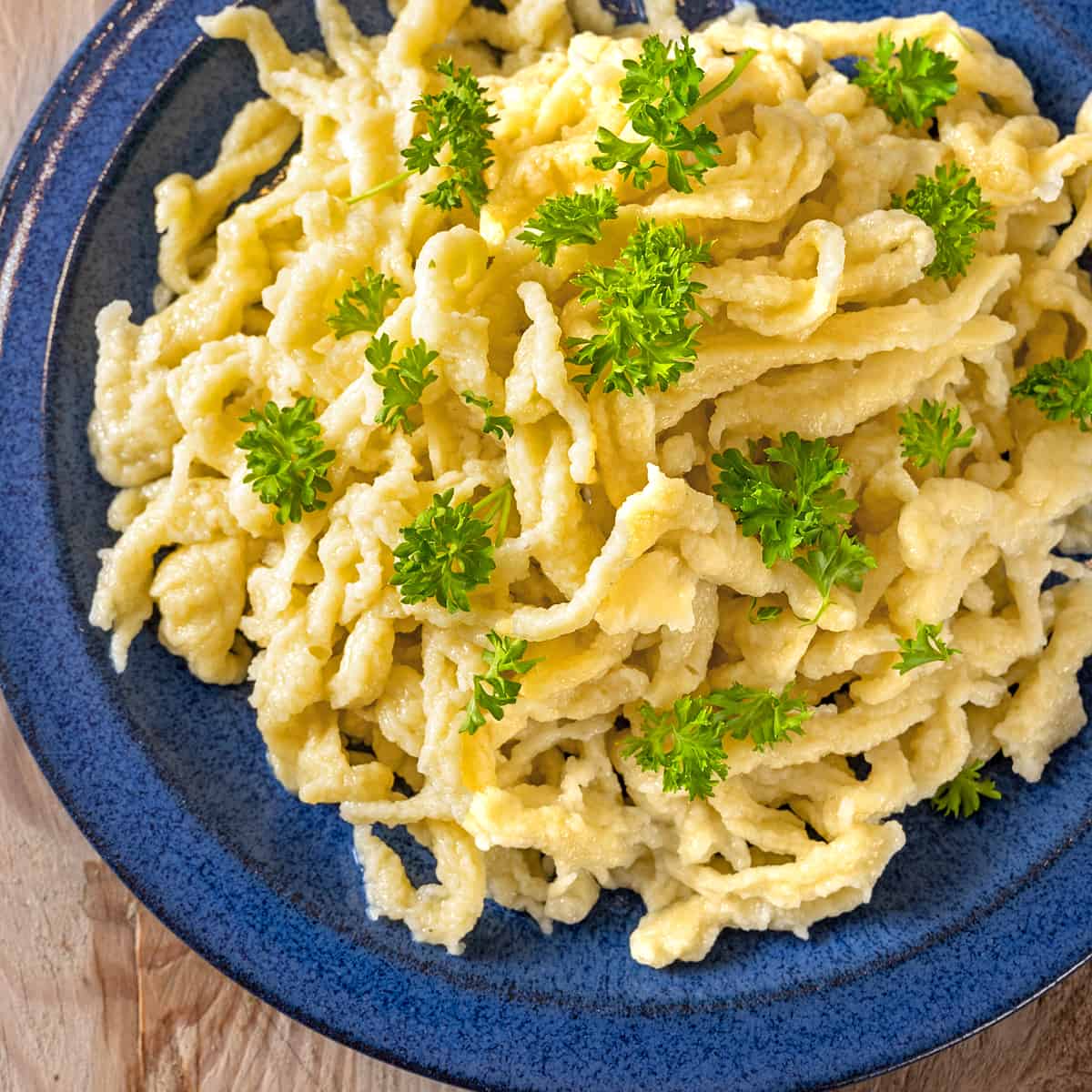
What to Serve with Spaetzle
Spaetzle is very versatile and can be served a variety of ways. Here are a ways to serve spaetzle:
- Buttered Spätzle: This is one of the simplest and most traditional ways to serve spaetzle. After boiling and draining the cooked spaetzle, toss them with melted butter and sprinkle with chopped parsley.
- German Cheese Spaetzle (Käsespätzle): Another Swabian classic and personal favorite, try my recipe for Käsespätzle (pictured below).
- With Sauces and Gravies: Spaetzle can be served with any sauce or gravy, like my favorite German Rahm Sauce, Onion Gravy, or Mushroom Gravy. Serve it with my classic German Goulash, Geschnetzeltes or Königsberger Klopse.
- With Meat Dishes: Spaetzle is the perfect choice to serve with any saucy meat dish like Jagerschnitzel, Rouladen, Sauerbraten, Pot Roast and Tri Tip Roast. It can also accompany your Schweinshaxe and Frikadellen.
- Pasta Salads: For a variation on traditional pasta salad, toss the spaetzle with fresh vegetables, herbs, a vinaigrette, and some diced cheese and ham.
- In Soups: In some regions, spaetzle is added to soups, much like dumplings. Drop small portions of spaetzle dough directly into simmering soup and let them cook until they float to the surface as in this Gaisburger Marsch and German Pea Soup.
Guten Appetit!
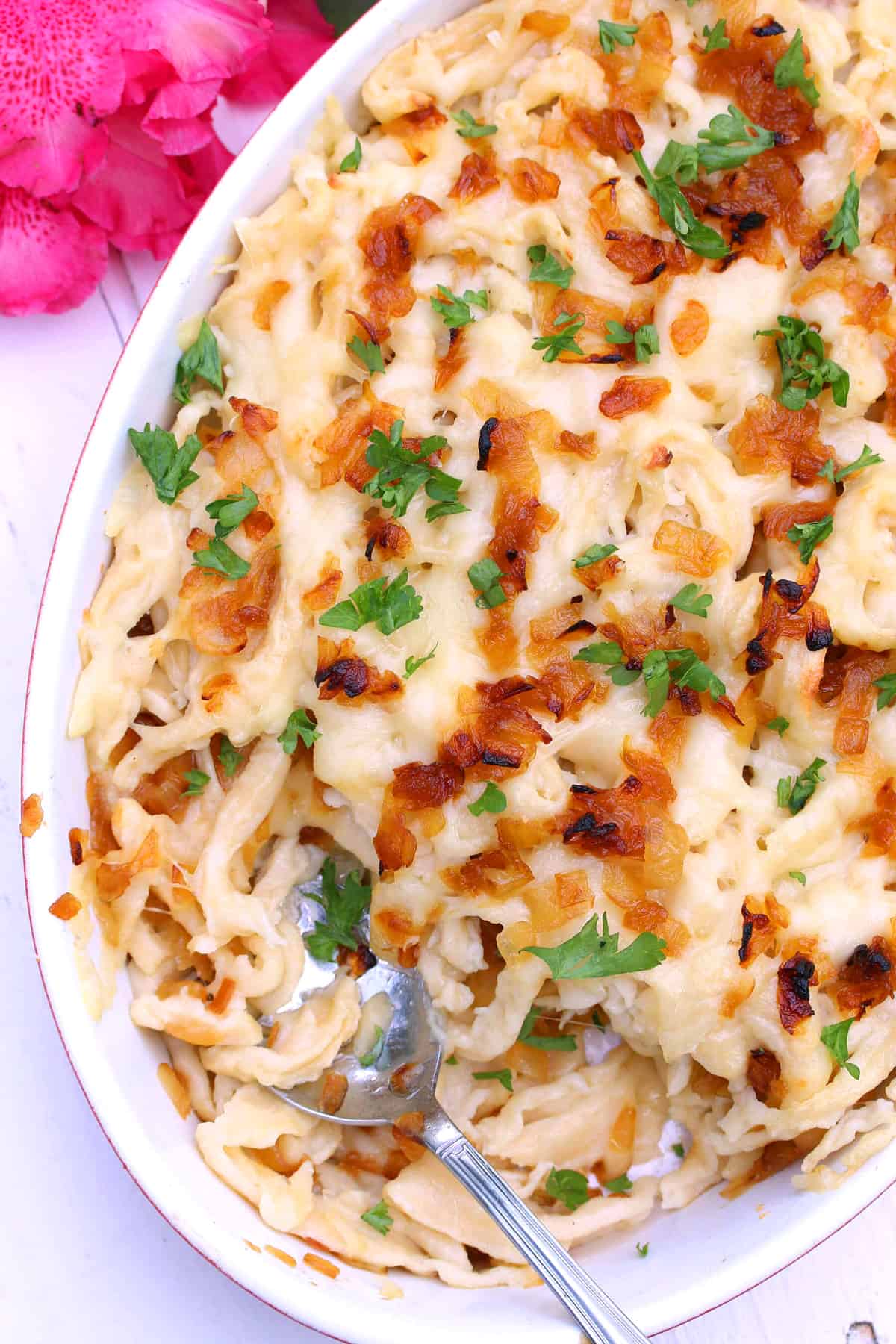
For more favorite traditional German dishes be sure to try my:
- Kaesespaetzle
- Rouladen
- Sauerbraten
- German Goulash
- Maultaschen
- Schnitzel
- Bread Dumplings
- German Potato Dumplings
- Zwiebelkuchen
- German Bread (Vollkornbrot)
- Bratwurst
- Currywurst
- German Potato Salad
- Rotkohl
Save This Recipe
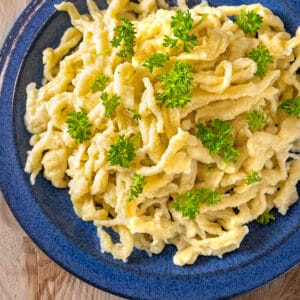
Traditional German Spaetzle Recipe
Equipment
Ingredients
- 2 cups all-purpose flour (you can also use whole wheat flour)
- 1 1/2 teaspoons salt
- 1/8 teaspoon freshly ground nutmeg , optional (not traditional but adds a nice flavor)
- 4 large eggs
- 1/2 cup milk or water + more as needed (milk produces a richer Spaetzle) (**add more flour if the dough is too runny, add more milk or water if it's too stiff)
- butter for serving
Instructions
- The Spätzle batter can be mixed by hand or by using a stand mixer which is much easier. Add the flour, salt and nutmeg (if using) to the bowl of a stand mixer. Stir to combine. Crack the eggs into a small bowl and whisk them. Make a well in the center of the flour mixture and pour the eggs in it. Add the milk (start with using slightly less and add more as needed). Attach a paddle attachment to the stand mixer and "knead" the dough for about 10 minutes or until bubbles appear (see pictured instructions for details). After 10 minutes or so of beating, use a wooden spoon to scoop and pull the dough. If bubbles/holes appear, the dough is done
- Bring at least 2 quarts of lightly salted water to a boil, then reduce to a simmer. Using a Spätzle maker of your choice (I use and prefer the Spätzle press), press the noodles into the simmering water and cook for about 2-3 minutes, or until the noodles float to the top. Use a slotted spoon to transfer the noodles to a colander to drain the hot water and then to large bowl of ice water (this firms them up for a better/chewier texture). After a minute or two transfer them to a colander to drain completely. Before serving, warm them through in a skillet with some melted butter.
- Make Ahead: The Spaetzle can be stored in the fridge for at least a couple of days and then reheated. Melt some butter in a large skillet and toss the Spätzle in it to heat through. Alternatively they can be microwaved in a covered dish.
Notes
Nutrition
Originally published on The Daring Gourmet on August 3, 2013



















The recipe is excellent except for the dough hook in the stand mixer part.
I have a standard Kitchen Aid mixer, and I used the 5 qt bowl. The dough hook is not deep enough to stir the batter as shown in the picture. It just swirks around on top of the batter.
So I switched to the paddle.
What kind of mixer are you using that the dough hook works?
I don’t have a dough hook on my mixer, so I made it in my Cuisinart with the dough blade. After about 5 min I had the bubble consistency for the dough. The spaetzle was excellent and so easy to make.
Awesome, Barb, I’m happy it was a success, thanks for the feedback!
SPEATZLE IS SWISS NOT GERMAN!!!!! MYOMA USED TO MAKE THIS ALL THE TIME THERES A DRY VERSION YOU CAN BUY AND BOIL VERY GOOD
Absolutely false, Margaret. Spaetzle (a Swabian word incidentally) originated in the Swabia region of southern Germany. Now, there are several countries that have something very similar, just shaped slightly different, but the dish known as Spaetzle is 100% of Swabian origin.
Amazing recipe!! Tastes just like my grandma’s! so authentic! Loved reading your history and families connection to this recipe.
I added butter, speck (fried pig fat) and maggi (my grandma’s staple) paired with schnitzel! I used a cheese grater, and it worked pretty good.
Easy to follow steps (and pictures of the holes helped a lot) and the texture came out great!! Super happy how it turned out!
My dad loved it!
I’m so glad you enjoyed it and I appreciate the feedback, Larissa, thank you!
I’m from South Africa. Was 6 months in the UK with my daughter and family. She bought me a potato pres with 3 blades, one for making spaetzel. Can’t wait to try your recipy. First time I hear the word spaetzel. Now that I have the press, definitely going to try this. Than you.
I have been making spatzle for years. My family is from Neuwirtzhaus/Zuffenhausen. The recipe I use is a little different, but my biggest question is how the heck do you clean the spatzle press???
Hi Barbara! It’s really not too bad :) After letting it soak in the sink for a few minutes the batter rinses right off. Some of them are also dishwasher safe.
I have a deep pot of COLD water waiting in the sink, and as soon as I’ve used up the dough, I immediately plunge the Kull Spaetzle maker into the pot.. Soak it for a bit, and it will be very easy to clean.
I spray the press with canola spray. It helps dough not to stick. If you let it sit after use, the dough is hard to clear the holes in the press. I usually soak in water till put in the dishwasher.
I always use spaetlze in my chicken noodle soup.
I make them fresh and it is the only noodle I use.
My family loves them.
I used your recipe but found that when they were done I could taste the flour still. Would that be because my mixture was to thick still or because I didn’t cook it long enough?
Hi John, it sounds like it’s an issue of having been undercooked.
I find it useful to make a few testers to check the seasoning. This will also let you check the cooking time before you commit to the whole batch.
First off I am not German or of German heritage. I am Serbian with Slovak grandparents on mother’s side. My grandmother and mom would often cook Chicken Paprikash with dumplings. They showed me how to make the Paprikash (not that difficult). The hard part for me was preparing the dough and cooking it. This recipe for the dough eases my worry that my dumplings
aren’t perfect. That said, I have to say I Love my spaetzle maker for making the dumplings SO much easier and ALWAYS perfect. I think Mom would be Pleased.
Thank You,
Mike D.
I don’t understand the 20 minute instruction. I beat by hand for literally one minute for one serve, two for two etc, and they come out fine, with many oohs and aahs when I serve to friends. What does all that extra time do?
Hi Shane, beating the batter longer is what ensures the proper texture which should be somewhat chewy rather than the soft texture of regular pasta.
I learned to make spaetlze from my step-daughter’s German grandmother. I typically add 1 egg per cup of flour and add water till I obtain a smooth dough and add to salted boiling water. It takes no time at all. Usually a substitute for potatoes.
I don’t have a stand mixer. Can this recipe work by hand or with a regular mixer?
Hi Kim, the dough is too stiff for a regular mixer. Yes, you can mix it by hand – growing up that’s how we always did it using a bowl and a big wooden spoon – just be prepared for a good workout! :)
The Kids and I had a great time making this Spätzle recipe. They made a horrible mess of the kitchen but what a great way to learn about your German Heritage, Am I Right? Quick question though, Does the amount of time you blend the dough make much of a difference? Just Wondering.
Fantastic, Desi! Mess aside, I’m glad the kids had a great time :) Yes, the amount of time is critical insofar as getting the right consistency (those air bubbles) is critical. How long that takes depends largely on speed, stamina, and muscle strength :)
My recipe sounds like yours and I bought a Spaetzle press decades ago. What I would like to know, because I can’t remember, is what kind of cheese is used in Schwaben for Spaetzle?
I lived in Schwaben for 24 years and have been making Spaetzle for much longer but always as a side dish with fried onions. Now that I want to make them the main dis I simply cannot remember what kind if cheese is used.
I know many restaurants here use Swiss but that is not the cheese it was served with back in the 1950/60s
Hi Ulrike, Emmentaler is the cheese that’s most often used for Käsespätzle. That can either be Swiss Emmentaler or Allgäuer Emmentaler (made in southern Germany). Here is my recipe for Käsespätzle: https://www.daringgourmet.com/kaesespaetzle-swabian-german-macaroni-and-cheese/
This is a delicious recipe! My grandmother, who was born in the beautiful little town of Enzklösterle, made amazing Spaetzle and served it with buttered breadcrumbs. So delicious! She would also put them in lentil soup. My mother brought all her daughters the bodacious Spaetzle press that you described, back from Germany years ago and I will hand it down to my daughter one day. We also love to crisp them up in some butter and then scramble in a few eggs the morning after. Very yummy! It’s a family favorite that my grandchildren enjoy as well.
Thank you, Candace! What wonderful memories to have of your grandmother’s cooking and that’s fantastic that you have such a great heirloom to pass on to your daughter. My daughter will likewise inherit mine one day :)
My Grandmother from Germany made them also to go with her pot roast. She used to toast plain breadcrumbs with butter in a frying pan then toss them with the spaetzle! So good!
I spent a year in Germany (Schwabenland, specifically) after college. I feel like I should get a medal for learning to speak German while among Schwaebisch speakers, but that’s a story for another day ;) Anyway, that’s when I was introduced to the deliciousness that is spaetzle. I’ve tried to make it many times over the years, but yours is THE best recipe I’ve found. Not to mention, it’s easy! Love using my stand mixer to do the hard work. Even my husband likes it, and he had proclaimed over the years to not like spaetzle. Thank you!
That’s so awesome, Laura, I’m happy this was a success and I appreciate the compliment – thank you! And I whole-heartedly agree – learning how to decipher and speak Schwäbisch makes you a total rock star!! :)